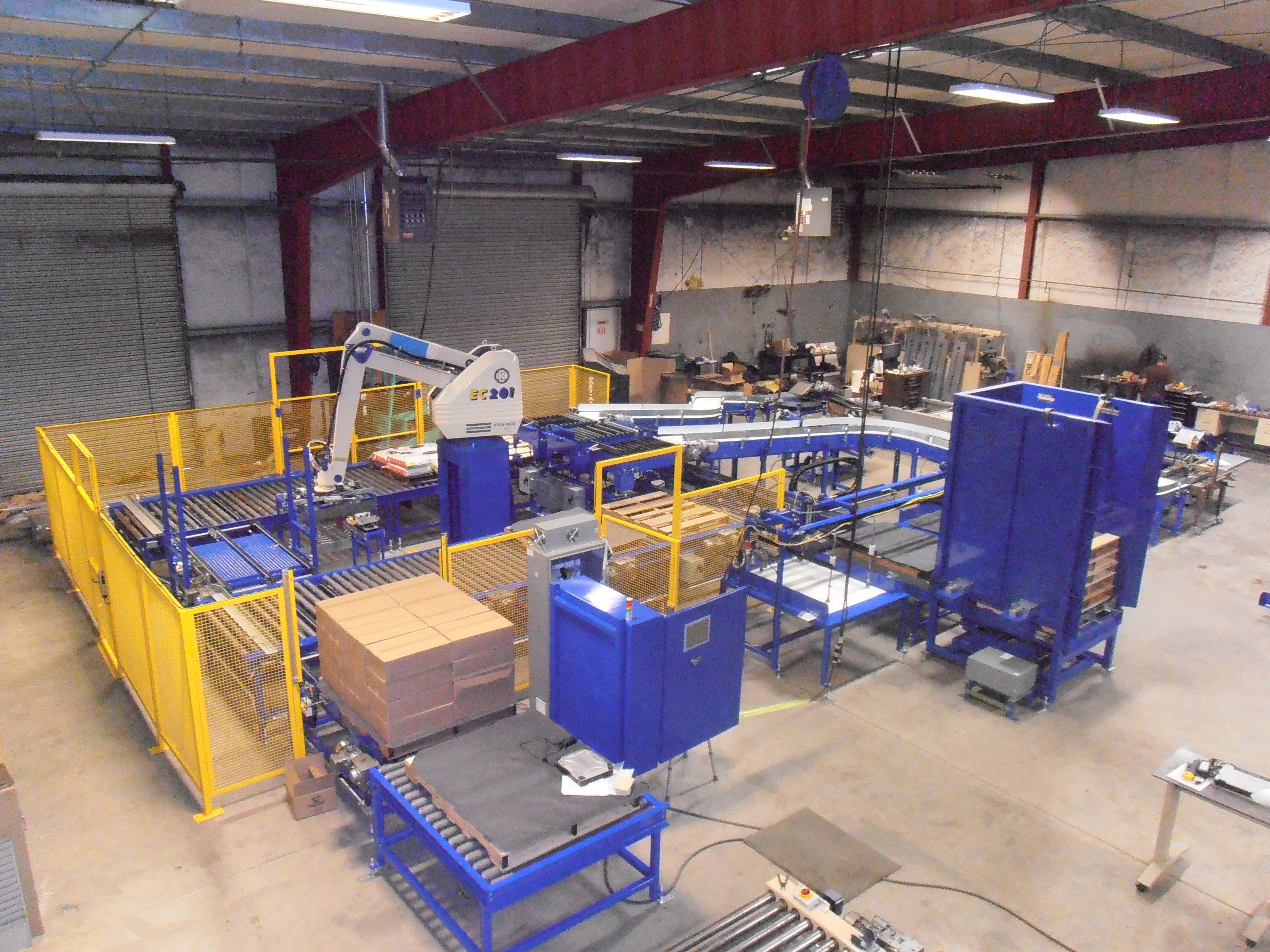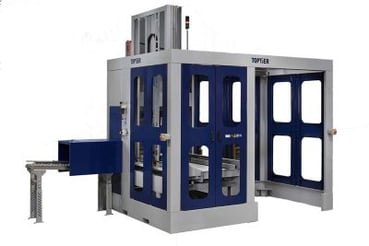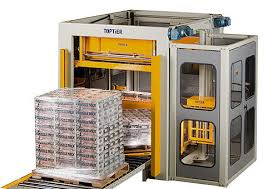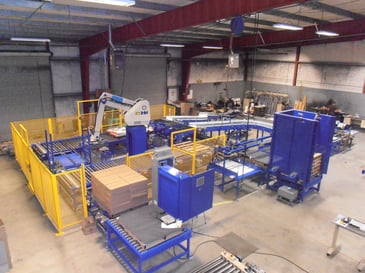
The Different Types of Palletizers
Productivity and efficiency are the main goals most warehouses, manufacturing plants, and other facilities strive toward, both daily and as a long-term goal. As consumer demands increase steadily, companies have to work to find solutions to their productivity issues. Automation is the answer to many productivity questions, but many facilities utilize a trial-and-error approach before investing. One of the expected points in an application that lacks efficiency is the secondary packaging line.
In many operations, trucks must be loaded and unloaded swiftly and effectively while protecting the products that ship out. Every facility has a slightly different approach, as every facility processes different products—unitizing loads in a beneficial process to both efficiency and profitability.
Unitizing loads is creating one solidified unit out of many smaller units. It works to protect the primary packaging and the products loaded together during a rough transportation process. Unitizing loads is also effective in cutting down truck loading and unloading speeds. The preferred method of unitizing loads is palletization before stretch wrapping the products on the pallet. Discover the different types of palletizers available, along with the considerations for your unique application.
Palletizing by Hand
Palletizing by hand is the old-fashioned and most inefficient way of palletizing loads. Hand palletizing is a time-consuming and labor-intensive process that can slow down an operation. Manually palletizing loads requires workers to place individual items on a pallet, one at a time. Below are a few pros and cons to this method of palletization.
Pros
While this is a labor-intensive and outdated method, there are a few plus sides to manually palletizing loads. Check them out below:
- No initial investment for a machine: Save money initially.
- Takes up less floor space than a machine in a warehouse.
Cons
There are quite a few downsides to hand-palletizing loads, especially in the long-run. A few of them are listed below.
- High-labor costs: You lose money in the long-term.
- Higher potential for worker injuries: Higher worker injury costs.
- Slower speeds: Less output.
- Less consistency in quality of loads: More potential for primary packaging and product damage during transport.
- Susceptible to workforce shortages.
Palletizing by hand is an inefficient, old-fashioned option that often costs companies more than the investment in a palletizer machine long-term. Palletizer machines cut down on labor costs and increase the efficiency of any operation. Hand wrapping can also lead to worker injuries, as it is highly physical labor. Investing in a palletizer machine is ideal for cutting down on worker injuries and the costs tied to them.
Pick N Place Palletizers
Another one of the different types of palletizers is a robotic palletizer. Robotic palletizers are typically positioned between a pallet dispenser and a pallet conveyor belt line that carries incoming products for optimal efficiency. A Robopac USA TopTier Robot Pick n Place Palletizer offers solutions to previous problems with robotic palletizers. With a robotic palletizer from Robopac USA, your operation can enjoy all the following pros:
- Best value for palletization for any product line.
- Easy to use.
- Highest safety rating possible.
- Bottom-up support of products.
- Small footprint.
- Configurable for your space availability.

The Robot Pick n Place Palletizer from Robopac USA solves one of the largest issues with robotic palletizers, namely the lack of bottom up support. Our palletizer offers servo-controlled row pick and place solutions where the product is 100 percent bottom supported until deposited on the load. That leads to higher rates and the ability to handle nearly any product.
Infeed Palletizers
There are two types of infeed palletizers: low infeed and high infeed. In general, they both use an infeed conveyor and a row former to orientate products into layers and form pallets layer-by-layer. These systems can be very reliable, cost efficient, easy, and safe to operate. The patented concurrent stretch wrapping function available on TopTier and Robopac infeed systems provides, perhaps the greatest advantage, with a compact, 2-iN-1 solution to palletizing and stretch wrapping. 
Low Infeed Palletizer
Low infeed palletizers work with existing floor-level conveyors, making them perfect for facilities with existing floor-level conveyor systems.
Low infeed palletizers utilize modular engineering to achieve one to three layers per minute. Below are a few specs from a TopTier low infeed palletizer machine:
- Can infeed 23 to 60 inches.
- Has a 4.5-to-29-inch case dimension range.
- Has a maximum case height of 18 inches.
- Has a 38-to-50-inch layer dimension range.
- Has a minimum footprint of 162 by 115 inches.
All low infeed palletizers from TopTier come equipped with a modular design, EasyStack software, EuroDDrive gear motors, color touchscreen, and B&R Servo drives. All of these features work to increase the productivity of your operation’s secondary packaging line.
High Infeed Palletizers
High Infeed Palletizers are upper-level infeed palletizers that offer the highest speeds available. Robopac's shared modules’ layout maximizes the layout flexibility while reducing the costs by increasing manufacturing speeds and total control of the machine’s efficiencies. Discover a few details about our high infeed palletizer machines:
- One to four layers a minute.
- Has an infeed height range of 108 to 148 inches.
- Has a case height of up to 36 inches.
- Has a minimum footprint of 80 by 80 inches.
- Can handle weights of up to 1000 pounds.
All high infeed palletizers from Robopac USA come with modular engineering. Modular engineering allows for higher flexibility in the configuration of machine components, so the induction and load exit orientation can meet your production’s exact requirements.
Robotic Palletizers
 There is a range or manufacturers like Fuji, ABB, and Fanuc —all with their own unique approach, advantages, and limitations. While these systems usually require a greater capital investment, they can also provide broader versatility and can manage multiple infeeds. An array of End of Arm Tools allow for a number of product types including sacks, bales, and pails.
There is a range or manufacturers like Fuji, ABB, and Fanuc —all with their own unique approach, advantages, and limitations. While these systems usually require a greater capital investment, they can also provide broader versatility and can manage multiple infeeds. An array of End of Arm Tools allow for a number of product types including sacks, bales, and pails.
Supporting content provided by RobopacUSA.
